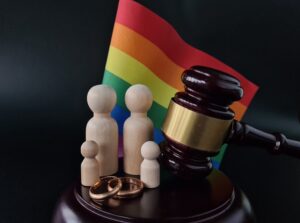Ways the Law Falls Short in Ensuring Equal Rights for Same-Sex Couples-Part 1

The numerous ways that the law falls short of ensuring equal rights for same-sex couples, depends really on where you live, if and where you got married and if it is even recognizable by your local officials. Before we can discuss the short falls of ensuring equal rights to same-sex couples, we first need to give a short history lesson into couples and marriage alike.
A Brief History on Marriage
Historically in many cultures, married women had very few rights of their own, being considered “property” of the husband as is the children born in this “contractual agreement”. In recent years, a marriage has become an equal rights union. Married woman have the same rights as a married man in most cases, and while still practiced, most wives are no longer considered “property”. There have been many documented cases of plural marriage, which by most states is an illegal union, commonly known as bigamy or polygamy. Usually defined as a man marrying multiple women. Also, not in as many cases but just as illegal, there are cases of women marrying multiple men, also known as polyandry.
Most couples plan to get married and have a family, career, and the picture perfect life everyone wants,or at least try.The same goes for same-sex couples. However, until the start of the 20th century, these couples were not as accepted as heterosexual couples would be. However, same-sex couples do plan to have the same as heterosexual couples would, typically this starts with marriage. While “Marriage” is defined very differently in many cultures, in the Western culture it’s largely described as a man and woman bonding in holy matrimony, acknowledged by state, organizations, religious authorities, tribal groups, local communities and/or your peers. In many cases, by engaging in matrimony, you’re considered in a “contract”. All of these “contracts” are accepted by state and federal government and laws, while receiving the benefits of a married couple i.e., tax breaks, medical and death benefits to name a few.
Come the turn of the 19th and 20th centuries, marriage in many states, is considered a union between a man and a woman. While many unorthodox forms of marriage are accepted in many different countries and cultures, here in the Western culture same-sex marriage is becoming more socially acceptable. In most cases, these unions are still highly frowned upon in modern culture, but are slowly getting growing support from everyday citizens, politicians and even religious groups.
Prior to 1996 the federal government did not define marriage. Any marriage recognized by the state, was recognized by the federal government, even if the marriage was not recognized by any other state. As was the case with interracial marriage until 1967. In 1996, the Defense of Marriage Act (DOMA) defined marriage as “a union between one man and one woman”. Once you were married and it was acknowledged by your local authorities, you immediately start receiving benefits that are ONLY available to married couples. These benefits include but are not limited to: tax breaks, communal property statues, Estate planning, Government, Employment, Medical, Death, Family, Housing, Consumer benefits and other legal benefits and protections. Since 1996 many cases have entered the court system attempting to strike down DOMA. It wasn’t until 2004 that the first same-sex marriage was recognized in the U.S. jurisdiction. It has since been legalized in different jurisdictions through legislation and court rulings.
To be continued, check back to see part 2 of this blog on Monday, August 5, 2013…
Leave a Reply